| Cres |
| Plitvice |
| Lokrum |
| Cavtat |
| Mljet |
| Susak |
| Osijek |
| Vis |
| Vukovar |
| Ilok, Aljmas |
| Vukovar reg. |
| Bol |
| Brijuni |
| Bol, Skrip |
| Nin |
Osijek - Essek - Mursa
My hometown for more than 74 years
Zvonko Springer, Salzburg, Austria, 1999
on this web with kind permission
My hometown Osijek accepted his "3 times lost son" during my book's promotion in June 1999. On April 13, 1945 I left Osijek serving as officer in the Croatian Army that had to withdraw under pressure of Marshal Tito's Armies. For the 1st time I believed that I would not be able to return home and my hometown had died in me forever. Miraculously I had returned weakened physically and broken in spirit on June 2nd as a POW. Some years later in November of 1961 I've said goodbye to my parents the 2nd time again accompanied by my wife and daughter (7) we left for Khartoum (Sudan). We had to "burn all bridges behind us" in order to be able to immigrate to Australia.
Then 3 years later I've joined a private company for which I'd set up a design office in Salzburg early 1967. As from 1968 we're visiting our families in Yugoslavia combining them with holidays on the Adriatic Sea. Our last visit to island Hvar was in 1986 after that we decided not to visit Yugoslavia anymore. The political situation was continuously worsening in Yugoslavia after the collapse of the "Iron Curtain" late 1989. We rushed by car from Salzburg to Osijek and drove my mother in her wheelchair to Zagreb on April 20th. A few day's later my mother and sister flew from Zagreb to Split and proceeded to Hvar. The aggression against Croatia started soon after and I never saw mother alive again. She died in July 1992 exiled on an island under siege. I invariably believed that the 3rd time would be the last one in my life leaving Osijek for good and forever.
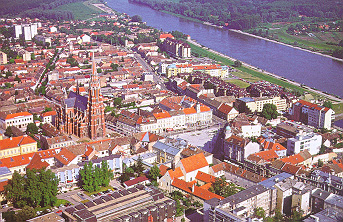
Arial view NW on
Osijek Upper Town with parish church of St. Paul & Peter.
Now let me try to recapitulate
the complex history of Osijek in briefly. You may like to know where
my hometown is geographically located. 0SIJEK is the biggest most
important town of East Croatia and situated on a raised plateau along
River Drava's right bank. City's coordinates are N 45 32' and E 18
44' at 90 m ASL and its center is about 22 km from the confluence
of Drava and Danube. Osijek has a geographical and topographic regional
position with a long and complex history important for the town's
and its districts prosperity and the development of its wider environments
too. Each historical period left on Osijek special characteristics
as an important strategic center of communication at crossways of
continental and water routes. The town was several times destroyed
and reconstructed during its over thousand years recorded past of
which I'll present a little cross section.
PRE ROMAN PERIOD AND ROMAN MURSA
The wider region of Osijek was inhabited even in the early Neolithic age. Archeological artifacts of incrusted pottery belonging to Vucedol culture and objects of bronze from ancient and earlier Iron Age proving continuity of human presence in this region. The Illyrians, members of Breuta tribe, were the first known inhabitants. In the 3rd century BC, after the invasion and migration of the Celts, a larger Illyrian-Celtic settlement was founded. This Illyrian-Celtic symbiosis developed with neighboring colonies and tribes using natural and water routes for exchange of goods. Discoveries of flinty opsydian and amber grains prove exchange with distant parts of Middle and Southern Europe since Neolithic age. At the end of the 1st century BC during Augustus' ruling Romans had conquered almost the whole Pannonia. Romans established a township named MURSA west of the Illyrian-Celtic settlement at beginning of the 1st century. Town of Mursa was built on foursquare basis and fortified with walls like any of Roman military fortifications and its location was probably at present Osijek Lower Town. In 133 AC during Hadrian's rule Mursa received the status of a specially privileged town of Roman Empire (Colonia Aelia Mursa). Thus Mursa became the seat of the Governor of Lower Pannonia and for a short time the seat of the Prefect of Danube Navy. Next to the town Romans built a bridge of fire-burned bricks (2 by 1 by 0.5-foot size) over river Drava. The bridge had a strategic importance for the defense of Empire's borders and linked East and West Pannonia.

Roman gold coins
from 1st to 4th century AD kept in Osijek Historical Museum.
Mursa owned much to its location on river Drava with several channels through swamps in present Baranja (north of Mursa was the old Drava riverbed linking it to Danube). There was a junction of six roads linking east and west with a wide surrounding of Pannonia flats as well with other towns along the Limes. Romans built a solid road through vast swamps in Baranja facilitating better communication and trading with the province of Upper Pannonia.
Interlude: In
summer of 1940 Drava had a rather low water table. A young museum
custodian went with few of us to the hidden entrance of a tunnel,
which led under Drava's riverbed. The entrance was few hundred meter
upriver from present the Water Tower of Tvrdja (= Citadel) in Osijek.
We wadded carefully into a rather wide brick lined channel carrying
carbide lamps and torches to light up the total darkness. At the
beginning there was mud ankle deep. It was very damp inside. We found
several fire-clay oil lamps "fibulae" and shreds of artifact that
one couldn't recognize properly. Our progress slowed down as the
mud layer became higher and as water started seeping through tunnel's
ceiling. After a while our guide saw a mud wall that wouldn't allow
further penetration. We had to turn back and took measurements of
how deep we wadded into the Roman built channel under Drava. Our
leader was rather happy about the collected artifacts and the length
of penetration that to about the middle of riverbed. One can see
very many "fibulae" at the museum of Osijek today. Most probably
there some we collected in that summer of 1940.
 |
 |
| Bronze fibula used as a lamp from 1st to 4th century. | Bronze horse figurine from 1st to 4th century. |
Christianity came to
Mursa about the beginning of the 2nd century and the town became
the seat of bishop's Diocese soon after. When the Aryans appeared
in Srijem Pannonia (Pannonia Sirmiensis) Mursa became their important
center and Bishop Valens a devoted supporter of and their utmost
defender on the Imperial Synods. As early of 3rd century Roman Sever's
dynasty constructed public buildings and temples that were adorned
with statues. There existed some public baths and an amphitheater
and palaces of rich noblemen in Mursa too. After Hadrian's rule Mursa
became a battlefield where many bloody battles were fought which
were crucial for the entire Roman Empire. In 350 AC Vetranius, an
old-aged commander of Illyrian legions, installed himself as a counter-emperor
in Mursa. A year later Emperor Costantius led a bloody battle against
his opponent Magnus Magnetius before city's walls. Historical sources
mention Mursa in year 360 for the last time probably the same year
Stilihon left Pannonia Valeria. The Romans destroyed the bridge on
Drava because of migrations and attacks of Vizi-Goths and other tribes.
River Drava became the Empire's outer border in Pannonia and Mursa's
fortification helped keeping intruders away. Mursa's last recollection
came from the year 591. From the early 5th century Goths started
devastating Mursa settlement to be followed by Huns, Avars and Slavs
who destroyed it completely.
FORMATION OF THE FUTURE TOWN OF OSIJEK
The Peoples' Great
Migration finished by the end of 7th century when Avars and Slavs
of Croat tribe inhabited this region. Croats founded a simple settlement
west of Roman Mursa near Drava. However by year 796 the Franks conquered
these lands after which the Avar-Slavic State collapsed. A Bulgarian
tribe drove out the Franks and occupied whole of Slavonia by 827
for short while. That settlement disappeared during the wars when
the Hungarians migrated here by end of 9th century. In the10th century
Croats renewed the settlement probably naming it OSIJEK. It was located
upriver of the present day Citadel and westwards of the remains of
lost Roman Mursa. The Slavic settlement's name was mentioned for
the first time in 1196 as "forum ac portus Ezeek" in a document of
the Croatian-Hungarian King Emerik . It was a market town that had
a harbor in possession of the Cistercian Abbey Cikador (near Bata-Szek
in Hungary) and a crossing over Drava.
THE MEDIEVAL TIMES OF OSIJEK
In the 14th century
Osijek had three feudal masters: Cikador Abbey, the Counts Korogi
and Gillermus who was the provost of the church in Titel. Korogi
family was involved a century long trial regarding pawn-purchase
with Cikador Abbey because of navigation and market taxes, as incomes
were rather high at this major crossing between Baranja and Slavonia.
Early 15th century Korogis built a castle surrounding their feudal
settlement with walls and ditches enlarging the urban area beyond
the present-day Citadel's area. Osijek became feudal ruler's seat
from which Korogis controled their neighboring estates. Stjepan and
Ivan Korogi were the Civil Governors of Macva region along Sava River
too. Gaspar Korogi fell in a battle with the Turks in 1472 after
that this feudal family died out.
Afterwards Osijek changed
several feudal masters and V1adislav, the King of Hungary and Croatia, resided
1495 in Osijek too.Owing to its geographical position Osijek became the most
important center of trade and culture of Slavonia in the Middle Ages. Some
young men from Osijek attended Universities in Vienna and Wittenberg between
1460 and 1504. Catholic parish church in Osijek was explicitly mentioned in
a tax payers list of 1332 regarding large amounts of church money. One doesn't
know much about the Medieval Osijek because all buildings and monuments were
destroyed during the Ottoman attacks. However there still exist several royal,
aristocratic and clerical documents including a few issued by the town Osijek
itself.
TURKISH TIMES OF OSIJEK
Following the battle
at Mohacs August 1526 the Turks conquered and partly destroyed Osijek.
The Turks recognized town's strategic importance and the restoration
began in 1528 when they built a solid fortress. In 1529 Sultan Suleyman
Kanuni came to Osijek leading the Ottoman army against Habsburgs
in Vienna. Since then almost every Turkish military expedition into
Hungary passed through Osijek. Probably since 1529 Osijek became
a "Kadiluk", (Kadi's county i.e. oriental civil judge) and temporary
seat of Sandjak that was Turkish first military-administrative unit
founded in conquered parts of Slavonia.
Later Osijek became a "Kapetanija" (Captain's
county) and "Nahija" (a kind of administrative unit in Ottoman Empire). About
1566 Suleyman II. built the famous bridge over Baranja swamps, which was a
road on wooden props leading in curved line from Osijek to village Darda about
8 km far. This facilitated faster economic development of Osijek becoming the
most important and probably largest town in Turkish Slavonia. Osijek was divided
into three urban units: citadel, town and suburbs. At the widely known markets
held tradesman congregated from all parts of the vast Ottoman Empire in times
of fairs.

Suleyman's Bridge and Turkish Osijek - 1684 engraving view NW.
Among most important
town's public buildings were Suleyman-Han's Mosque (formerly a church),
Kasim-pasha's (1558) and Mustafa- pasha's Mosque (1569), "Mekkema" (courthouse), "Medresa" and "Mekteb" (secondary
and primary Moslem schools), Bey's sarai (Bey's court) and "Sahat-kula" (Clock
tower). During the Turkish occupation the town was populated by Turks
who immigrated after the conquest. In suburbs lived a few dozens
of Christian families and a smaller trading colony of the Ragusans.
According Evlija Celebija, a travel writer the town consisted of
400 houses and 7 "Mahalas" (watchtowers of the town) where as in
suburbs were more than 2000 houses in 1663. The bridge at Osijek
was known for a long time as a worldwide wonder and attracted many
writers and adventurers from all parts of Europe giving rich inspirations
to painters' imagination. In 1664 Nikola Zrinski partly burned this
impressive bridge, but the Turks soon restored it.
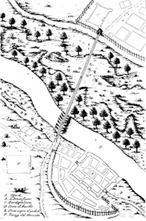 |
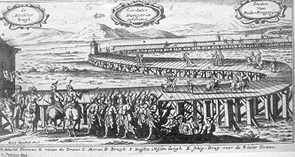 |
| Plan of Turkish Osijek of 1610. | Engraving of Suleyman's bridge from Osijek to Darda from 17th century. |
BUILDING THE NEW OSIJEK
The Austrian authorities
reconstructed the Turkish fortress in Osijek temporarily soon after the
whole of Slavonia was liberated. The building of a fortress resembling
a Dutch fortress of flat type began in August 1712 and was almost completed
by 1719. Within its walls the basic urban concept of the former Turkish
town was retained. A crown-fort (Kronenwerk) was built on Drava's left
bank 1719/21 opposite to the new fortress on the right bank. The new fortress
had three gates named "Valpovo" (West), "Water" (North i.e. towards Drava)
and "New Gate" (South). In 1783 was opened the fourth one "Imperial Gate" (East)
through which a road lead to the Lower Town. The urban construction inside
the fortress in Baroque style changing completely the former appearance
of an almost oriental town. Builders used as main material salvaged Roman
bricks again same way as few ones before. As from 1690 the city administration
was being organized. After the Chamber of Estates in Slavonia completed
the inventory the Town Osijek was given the City Statute in 1698.
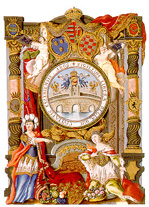 |
 |
| Coat of Arms in Charter of proclaiming Osijek "Royal Borough" in 1809. | St. Trinity Square in Tvrdja with Petrash's Plague Statue |
Some inhabitants of Turkish suburbs started moving westwards of the to-be-build fortress creating the "Upper Town" in 1692. Other moved eastwards down river and founded the "Lower Town" in 1698. At first the Upper Town and the Fortress were one administrative unit. In 1702 the Upper Town obtained a separate parish administration. Osijek was then divided into three separate administrative units: Upper Town, Fortress or Citadel and Lower Town. From 1735 to 1783 Osijek was the seat of the Austrian Army Chief Commander for whole of Slavonia and from 1737 to 1745 the Seat of Country Administration for Slavonia. In 1745 Osijek became the government's seat of restored Virovitica District, which remained so until this District was abolished in 1922(!).
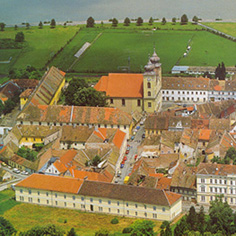 |
| View of Tvrdja western part in the Osijek Citadel. |
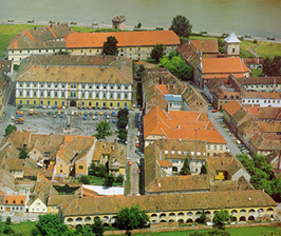 |
| View of Tvrdja eastern part in the Osijek Citadel. |
For many years the three
urban units of Osijek were developing quite separately only to be incorporated
into one City parish in December 1786. This partition made strong impact
for the town that is still felt up today. In 1792 German colonists started
to inhabit thetown's southern territory where another district developed
know as the "New Town" now-a-days. Many calamities struck Osijek and
its inhabitants of which the epidemic of plague was the hardest. The
widow
of General Petrash donated funds to erect a Plague Statue at the center
of Citadel's quadrangular main square. It is a lasting memento of devastations
caused by the plague. This statue is one of most beautiful Baroque monuments
in Osijek now.
MODERN OSIJEK alias ESSEGG or ESSEK
By the end of 18th century Osijek has become the military, political, administrative, economic and cultural center of Slavonia. The Imperial Chamber and the Army were a heavy burden for Osijek so citizens wanted to free themselves from their direct influence. Finally Osijek gained its freedom when it was proclaimed a free and royal town, a "Royal Borough", in 1809. The Upper Town had obtained the privilege for two fairs a year in 1712 already. Later Empress Maria Theresia ratified annual fairs on St. George's and St. Elias' Day too to be held in the Citadel for 3 days as from 1747. The visiting tradesmen were coming from Hungary, Bosnia, Carinthia, Styria and other regions of the Monarchy.
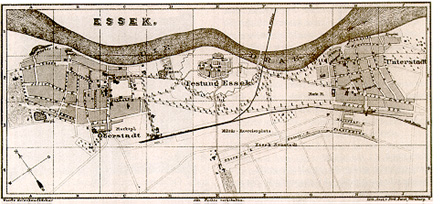
General plan of Osijek Town as per 1893.
The real impetus to Osijek's economic development came when a solid road over Baranja swamps was constructed after several interventions of King Joseph II. It became an important link between Middle and Western Europe that was cut of for about a century after the destruction of Suleyman's bridge. Regular mail services were established from Osijek via Budapest to Vienna soon thereafter. Silk manufacturing started in Osijek in 1774 and it remained Monarchy's center of sericulture until 1850. The economic progress improved with the setting up the Trade & Craft Chamber for Slavonia in 1853. New banks, trade and crafts enterprises were incorporated and permanent backwater navigation started on Drava too. The town was firmly connected to its rich agricultural surroundings particularly with the arrival of first railways in 1869 as parts of Alfoeld's Line Subotica - Dalj - Osijek and Osijek - Villany.
The local railways of Slavonia
opened to traffic the line Osijek Nasice - Kapela in 1884. Soon started
operating other lines from Osijek to Vrpolje (1905) and Vinkovci (1910)
establishing links with Zagreb, Rijeka, Vienna and Belgrade. Town's population
counted almost 9.000 inhabitants at the turn of centuries.The horse-drawn
streetcar traffic began in 1882 to be replaced by electric streetcar in
1926. Public Telephone Company had 43 subscribers in 1884 already. A Swedish
match factory and a brewery started productions in 1856; various enterprises
produced agricultural machines (1864) and furniture (1892). Manufacture
of leather started (1873), of flax (1901), of sugar 1905, of candy and
chocolate products (1907) and brushes (1920), soap produce works opened
(1921) etc. The steam and electric mills commenced functioning in 1879
and 1911 respectively, an iron foundry worked since 1912. The electric
power plant started operating in 1926 and electric light installations
spread throughout the town. Osijek was the largest and industrially most
developed town in Croatia in first decades of the 20th century. At first
it developed into length as it was squeezed longitudinally between the
river and railway lines.
EDUCATION AND CULTURE IN MODERN OSIJEK
The spiritual life started
early in 18th century with the arrival of Jesuits who made Osijek their
headquarter. Jesuits were in charge of the new parish where they established
a small church in the Citadel on top of the late mosque foundations. Later
they built the two-tiered church of St. Michael on its place. Jesuits founded
the first primary school in 1712, then opened another one in the Lower
Town (1723) and some years later in Upper Town too. A small secondary grammar
school followed (1729) and a bigger one of classic stream opened in 1765.
Jesuits' significant spiritual activities had been abruptly stopped by
their expulsion in 1773. They would return to Osijek after some 160 years
later.
Concurrently with Jesuits
came Franciscans and Capuchins establishing their monasteries in Osijek too.
Franciscans instituted first a Secondary school and starting a College of higher
education offering studies in philosophy and theology later. Primary and Trade
schools opened as well as a Secondary grammar school in 1870. A Teacher training
college and a High Commercial school were founded in 1893 and the first Secondary
grammar school for girls in 1917 at last. Franciscans opened the first printing
house in Slavonia 1735. Almost every book written in Slavonia was printed there.
These works of Katancic, Kanizlic, Relkovic, Pavic, Cevapovic, Filipovic, Ivanosic
et Al.
In 1848 appeared the first newspapers in German "Der Volksredner", "Esseker Lokalblatt und Landbote" (1864), "Die Drau" (1868) and "Slavonische Presse" (1885), then in Croatian "Dan" (The Day, 1902), "Narodna obrana" (People's Defence, 1902), "Jug" (The South, 1918), "Hrvatski list" (Croatian Press, 1920), etc. A modern printing house was founded in 1902 facilitating the development of journalism in national language. Musical life in Osijek started with a "Tambura" band in 1847 and some years later a choral society "Lipa" (The Linden, 1876) which is still in existence. A number of famous musicians worked in Osijek: the first Croatian musicologist Franjo Kuhac, world wide renown violin-players Franjo Krezma and Lujo Svecenski, who later became the President of High Music School in Boston.
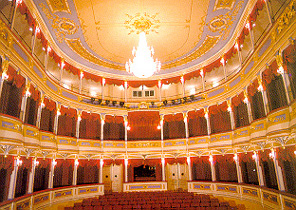 |
 |
| Croation National Theater at Osijek in Zupanijska Street. | Sculpture by Vanja Radaus of famous musician Franjo Krezma. |
Epilogue: I remember regular fairs held in empty fields between the Upper Town and the Citadel. City's four parts were still far apart from each other during my childhood time and it took a good hour with the electric streetcar to get from town's West end at Retfala to its East end at Zeleno Polje. The World War I. obstructed further development and progress of Osijek particularly after the disintegration of Austrian-Hungarian Monarchy late 1918. Osijek entered into the new state the Kingdom of Yugoslavia with a remarkable basis in economy and industry, administration and cultural organizations. Further progress was impeded after King's proclamation of dictatorship and the economic crisis of 1930's. In 1931 Osijek township covered an area of 57sq.km and had about 40.000 inhabitants.Osijek it declined steadily in comparisson to other towns' rapid progress in the Croatian Counties in the Kingdom of Yugoslavia.
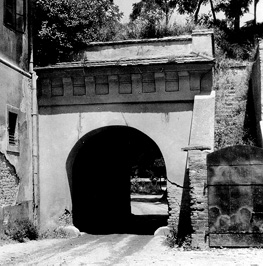 |
| Citadel's northern Water Gate opening to Drava River. |
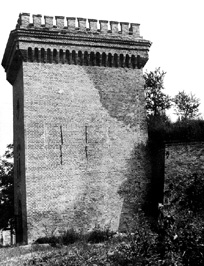 |
| Tower next Drava River at Citadel's northwestern corner. |
The present day Osijek changed significantly and one shouldn't wonder after the three major seizures in the 20th century. The town's populations changed very much during the past 70 years and there are few old families still living in Osijek now-a-days. The younger generations cannot speak or even understand the old indigenous "esseker" language at all. Esseker colloquialism used a mix of words from different languages like German, Croatian, Hungarian and Turkish. The population seizures started as from the Kingdom's dictatorial regime to be followed by major losses and migrations caused by 2nd World War (1941/5) aftermath. The particular change came as the result of upheavals during the Home War (1991/5). In 1991 the town had 171sq.km and the population grew to some 104.500 before the Home War started.
There is one token of my
hometown that had not changed yet: the mosquitoes. Just go out through
the Citadel's Water Gate near Drava and anybody would meet Osijek' s mosquitoes
there for sure! At last, visit Osijek spending a weekend taking a boot
from the Winter harbor and go for fishing or swimming on sandbanks of river
Drava. Also, do not miss tasting few of local cuisine specialties in one
of the many places one really enjoys meals and drinks. Wish you very good
times in my hometown!
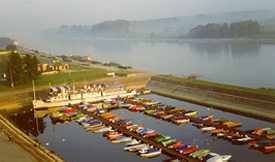 |
| Early morning view westwards onto Drava River and the winter harbor. |
 |
| Smoke-dried specialties by IMPEX Osijek: ham, bacon, sausages and kulen. |
Literature and picture sources:
1. Ive Mazuran: OSIJEK, Copyright
by "Litokarton" Osijek, 1971.
2. Jasenka Jurasek-Denin:
UVIJEK OSIJEK, Izdavacki centar Otvorenog sveucilista Osijek 1992.
3. Ive Mazuran: SREDNJOVJEKOVNI
I TURSKI OSIJEK, HAZU Osijek 1994, ISBN 953-154-040-3.
4. Dario Topic: OSIJEK I OKOLICA
- Posebno izdanje, IV., "OSJECKA RIJEC" Osijek - "RIJEC" d.o.o. Vinkovci 1998.5.
CROATIA AIRLINES IN FLIGHT MAGAZINE summer 1999.
DISCLAIMER : On URL: http://www.cosy.sbg.ac.at/~zzspri/ published pages are originals and authorized by copyright of Zvonko Z. Springer, Salzburg 1999.
Email Zvonko Springer at : zzspri@aon.at